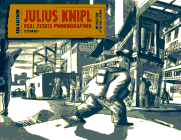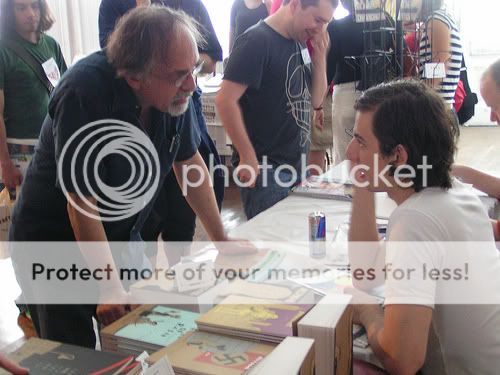Author Archive
Comics Time: Kramers Ergot 5
June 23, 2008Kramers Ergot 5
Sammy Harkham, Ron Rege Jr., Mat Brinkman & Neil Burke, Souther Salazar, David Heatley, Chris Ware, Elvis Studio, Gabrielle Bell, Kevin Huizenga, Anders Nilsen, Gary Panter, Jordan Crane, Leif Goldberg, Paper Rad, Fabio Viscogliosi, J. Bradley Johnson, C.F., Marc Bell, Dan Zettwoch, Tom Gault, writers/artists
Sammy Harkham, editor
Gingko Press, 2004
320 pages
$34.95
Can anyone here tell a story? You bet your ass. Unlike the preceding, breakout volume of Kramers, where narrative and non-narrative work were on more or less equal footing, the conventional comics hold pride of place in this installment. I mean, that’s a judgment call, obviously. Maybe it’s just me not liking the way a lot of the fine-art-inflected work here–the humor-strip-via-collage by Souther Salazar, Leif Goldberg’s paintings–look on a two-dimensional printed page. Or maybe it’s just me thinking that the more far-out sequential art–J. Bradley Johnson’s non sequitur-laden gag (?) strips, Fabio Viscogliosi’s T. Rex-quoting series of epigrammatic illustrations, even work from the usually reliable and hilarious Paper Rad and Marc Bell–is sort of unfocused and not quite up to snuff. Heck, Gary Panter’s contribution is just thirty seemingly random pages from thirty years’ worth of his sketchbooks–an impressive achievement, to be sure, but the sort of thing that would be just as interesting as a blog post as it is in an avant-garde anthology.
So the spotlight is stolen by the storytellers. Two contributions in particular are real world-beaters, strips that leapt right out at me during my first flip-thru of this book years ago and continue to set a standard for my appreciation of short-story comics. The first is David Heatley’s apocalyptically revealing “My Sexual History,” a complete rundown of every embarrassing/erotic/both detail of Heatley’s sex life from his childhood through his marriage (excepting some stuff with his wife he chose to keep private). I’ve seen this dismissed, by Johnny Ryan’s parody strip for example, as mere exhibitionism, but that ignores the sophistication of Heatley’s approach to designing the strip: the uncomfortable avalanche of intimate details is conveyed through an eye-oppressing 48-panel grid (!) on each page.
The second hall-of-famer here is Kevin Huizenga’s “Jeepers Jacobs,” the story of a preacher grappling with both the concept of Hell–which he’s defending the literal truth of against less orthodox theologians–and how to deal with his new golf buddy, non-believer (and Huizenga’s trademark everyman) Glenn Ganges. Huizenga handles the sort of suburban-fundie character that 99% percent of his audience presumably loathes on sight not just with sympathy, but with intelligence, setting up his arguments and weaving his faith throughout his daily routine in a fashion we’d recognize from our own political or aesthetic pursuits. The ending’s a killer too; I know others had a different experience, but I didn’t see it coming at all.
And there’s more. Jordan Crane starts down the road of violent morality plays he’s still fruitfully pursuing today; Chris Ware’s segment from Building Stories feels a bit too much like a chapter from an ongoing serial but it’s still, you know, Chris Ware’s Building Stories; comparatively linear work from Elvis Studio and Mat Brinkman alternately tickles and horrifies; Tom Gauld has a series of knee-slapper vignettes involving the writing habits of famous authors; Dan Zettwoch’s lengthy story about a church-group field trip that may or may not end in disaster doesn’t hold interest for its duration, but I kind of appreciate its ambition. Overall, the avant garde tag means less for this volume than the more apt description of “very good.”
You Deserve This!
June 21, 2008SPOILERS FOR THE HAPPENING AHOY. Sorry, I tried, but I just couldn’t do without.
Before you read anything I write about M. Night Shyamalan’s The Happening you should stop and read everything Jon Hastings has to say on the subject. He does yeoman’s work as a Shyamalan apologist, trying to defend what were (to him and to me) obviously conscious choices made by Shyamalan in this movie against critics whose (to him and to me) increasingly comical and depressing conservatism led them to believe Shyamalan was trying to make a completely different movie and just screwed it up.* A movie that knows its place, basically. For god’s sake, do these people not understand there’s more than one way to skin a cat?
As you can gather I liked it. I’m not over the moon for it–in Shyamalan’s oeuvre I prefer The Village (haven’t seen The Lady in the Water but I sure am gonna now, and while Jon is quite right to point out that it’s doing something entirely different than Spielberg’s thematically and structurally** similar War of the Worlds, I find I prefer what War of the Worlds did. But the vituperative response to it is really completely unjustified. And while I know it’s a mug’s game to dismiss critics on an ad hominem basis, it’s tough for me to see the hostile reaction as anything but its own ad hominem rejection of Shyamalan for being too serious and too big for his britches, refusing to deliver the crowd-pleasers he’s apparently supposed to be delivering. That, and as I alluded to above, I’m literally sitting here shaking my head that people could watch (say) Mark Wahlberg’s performance in this movie, or John Leguizamo’s, and it doesn’t occur to them that they weren’t gunning for The Departed in terms of acting style. It’s like people complaining that Nicholson was over the top in The Shining.
I think the way to look at The Happening is as a satire with violence instead of comedy. (I’m a big fan of this kind of substitution, hence my theory that Eyes Wide Shut is a horror movie with sex instead of violence.) What you have here is a film in which the Earth basically decides to take a small corner of itself and murder all the people on it that it can. Then it stops, and then at the end of the film it picks another corner and starts again. Throughout, the horror imagery is of people calmly methodically killing themselves–in essence, reducing everyone’s personal stories and goals and ethics to a bloody punchline.
The death that struck me hardest is that of John Leguizamo’s grumpy, sort of unlikeable math teacher. Here’s a guy who despite the possibility of losing his own wife still finds the time to make his buddy’s wife, who he’s never liked, feel like a piece of shit; who also has the presence of mind to help keep a fellow survivor calm by getting her to work through a math puzzle in lieu of freaking out; then BOOM, he wanders out of a car wreck that killed his fellow passengers, plops himself down in the middle of the road, grabs a piece of glass and goes to work on his wrist. And when you think about it, what are the final two scenes–life goes on with Wahlberg and Zooey Deschanel, while life ends in Paris–but that same sick joke writ large?
So yeah, what I like about The Happening is that it’s the anti-Signs Not that I didn’t like Signs, because I do, it’s just that this movie is nihilistic where that one was optimistic perhaps to a fault. Is Shyamalan really this angry about climate change? Did the critics just break him down? Who knows, but I’ll eat it. As Wahlberg sing-songily deduces his way through the catastrophe, people keep dying and dying, and as he and his wife (and the poor little girl they’re supposed to be keeping safe) decide to make one last grand gesture of love, the dying stops, and ultimately it’s all sort of meaningless. Meanwhile a billboard outside a model-home McMansion poised to turn the middle of nowhere into an exurb proclaims, in the familiar and infuriating language of American advertising, “You Deserve This!” Indeed.
* Surely the Betty Buckley sequence illustrates that Shyamalan knows how to be really, really scary and could do so throughout the film if he felt like it. He didn’t!
** Very similar, in fact: initial urban outbreak, flight through the highways and byways, commandeered cars, the shattering of ad hoc groups, savagery among survivors, offerer of refuge becomes immediate threat and also happens to be nuts, last horrible moments, threat peters out, kinda happy ending. Shyamalan just adds an extra scene that shifts the balance, which is just one reason why, as Jon says, it’s incorrect to view him as a Spielberg manqué.
Just for one day weekend
June 21, 2008
Because I fail at self-promotion I’ve neglected to mention that my comic book Murder is on sale at the Partyka table at Heroes Con right this very moment. If you’re there you might consider buying it. If you’re not, you still might consider buying it.

Comics Time: Cartoon Dialectics Vol. 1
June 20, 2008Cartoon Dialectics Vol. 1
Tom Kaczynski, writer/artist
Uncivilized Books, 2007
26 pages
$5
This minicomic collection of strips culled mostly from magazines by MOME contributor Tom Kaczynski is a showcase for both his humanistic critiques of techno-capitalist society and his almost horrifyingly proficient use of color. Seriously, has he done any color work in MOME before? Because this stuff knocked my socks off. Give this man an Eisner for his fruity red-oranges alone!
The comics themselves are a strong selection, packing a lot of variety and value into a five-buck mini. Cartoony cover character Ransom Strange kicks things off by exorcising a corporate Cthulhu knockoff that had been plaguing some poor modern man with credit card debt and body image issues. (If only it were that easy!) It’s a funny, fun little metaphor, one I actually think could be expanded upon.
Next up is a lengthy, luddite comics essay pitting the Web-based post-print world against Kaczynski’s preferred realm of “meatspace,” which here comprises everything from printed books to taking a dump. While I agree with Kaczynski that anti-print evangelism gets tedious, anyone who’s blogged as much (and enjoyed it as much!) as I have should be able to tell you that you can get a lot out of not being an ink-stained wretch and not idealizing the pre-Internet age. (Would something like MOME be as successful as its been without the Internet to pass the word around?) The strip kind of confuses its case by lumping advertorial in print magazines in with the evils of the digital age, as though a) that’s new and b) one has anything to do with the other. If you’re going to create a good-evil dichotomy between analog and digital, you can’t have it both ways. Still, though not quite successful on a philosophical level, it’s a lovely-looking strip, with judiciously chosen images representing the various ideas and idea-spouters and Kaczynski’s precise use of thicker blacks creating a memorable Easter Island sequence.
The collection is rounded out by five one-page strips that really showcase Kaczynski’s color palette to a range of affect. There’s a pair almost Julius Knipl-style anecdotes about a just-shy-of-believable quirks of our commoditized ideas and emotions–a resort community designed to provoke existential ennui called Taedium Plains, and “Boris Lecture, the famous architecture critic,” who can’t quite bring himself to completely purge his book collection Zizek-style every couple of months. A third strip preserves Kaczynski’s trademark linkage of phsyical and mental artchitecture in depicting how the male member of a couple compartmentalizes his memories according to the bedrooms in which they took place. A fourth recounts the domestication of the cat with adorable clarity, and the fifth and final strip is a tale of excessive consumption of gross junk food on a road trip familiar to anyone who’s ever grabbed a bag of Combos in a rest stop on the New Jersey Turnpike. Lovely, enjoyable, occasionally provocative stuff, all in color for five bucks.
Carnival of souls
June 19, 2008* Reviews of things I haven’t seen part one: Tom Spurgeon reviews Jason’s new collection of old material, Pocket Full of Rain.
* Reviews of things I haven’t seen part two: my pal TJ Dietsch reviews Jack Kirby’s OMAC.
* Reviews of things I haven’t seen part three: Jon Hastings keeps on talkin’ up M. Night Shyamalan’s The Happening. This time he’s asking potential audience members to go in with the assumption that Shyamalan, for want of a better phrase, meant to do that.
* Review of thing I have seen: Jim Treacher talks about The Incredible Hulk.
* Crisis at DC Comics: Dick Hyacinth offers a wide-ranging musing on the failure of Final Crisis to ignite the audience, while Douglas Wolk focuses on its implications for New Gods/Fourth World continuity.
* Lara Flynn Boyle is continuing to blog about Twin Peaks.
* Jason Adams spotlights his five favorite monsters from the films of the ’00s.
Comics Time: Julius Knipl, Real Estate Photographer
June 18, 2008Julius Knipl, Real Estate Photographer
Ben Katchor, writer/artist
Little, Brown & Company, 1996
106 pages
$12.95
Glimpses of lost New York City are both thrilling and sad. The times I’ve encountered them–the absurdly ornate urinals in the Marvel Comics lobby a few office buildings ago, an elaborate and unused pneumatic tube system in an office I once visited while working as a production assistant on a short-lived David Milch cop show, tiny mom and pop repair shops with Eastern European names on small streets buried beneath bridges or behind the entrances of tunnels–have left me wondering how wonderful these things must have seemed in their heyday, and how futile the enterprises must seem now.
What a stroke of genius, then, to create an entire comic strip about lost New York–the lost past of anyplace really; no need to be chauvinistic about it. Double-genius to make it about an imaginary lost New York–eerily, surreally plausible business that never existed but might have. Licensed expectorators with the proper permits to spit in the faces of whoever those who hired them designate. A tripwire system running from the graveyard to the apartments of the bereaved, to alert them if their loved ones have risen from the dead. A bus line-slash-roving theater that strategically places actors along its route for the viewing enjoyment of its riders. A system of cattle ranch-style marks on the collars of laundered work uniforms to stake out the turf of rival commercial laundries. The niche businesses that Katchor’s everyman protagonist Julius Knipl encounters on his perambulations (that’s really the best word for his long-strided journeys through the city) fit neatly in the cracks of our waking life amid the uncountable multitude of sights and sounds in the city, to the point where it’s easy to convince ourselves we really have seen the brand of the Mansoyl Towel and Apron Supply Co. on the sleeve of the busboy at the restaurant where we spent our lunchbreak.
What I’m trying to get at is how well Katchor conjures up the repleteness of the city. In a town conjured from the accrued history of millions of people over decades of time, there is, almost literally, something for everyone. A big part of this is the way he frames his panels, using odd angles halfway between a normal stage view and the cantered frames of Expressionist film, disorienting us, showing us not just businessmen and their stock in trade but suggesting their showrooms’ dusty corners and the chipped paint of their ceilings, the airshafts of their tenements and the shadows cast by their radiators as the afternoon light strikes them through a lead-painted windowframe. It’s a tactile environment, one you can dive right into with no sense that beyond the panel border, there’s a calm cool nothingness.
But the best way to get across what I’m saying, I think, is by pointing out one of the strip’s recurring devices: Experts who can interpret minute variations of everyday human behavior to further their business ends. There’s one who can predict the turns of the economy based on the frequency and severity of brassiere-strap slippage. Another has set up a rooftop observatory to pinpoint the degree to which everyone limps. In the collection’s climactic, longer piece, “The Evening Combinator,” a newspaper publishes accounts of people’s dreams, the details of which are gleaned from studying the grooves in their mattresses, the cadence of their snoring, how their eyes look as they wake up.
What comes across from these strips is the sort of dizzying impression that the city is big enough and full enough for someone to have devoted a lifetime to the refined research of this sort of arcana, and that there’s enough demand for it to make a living. For me it triggers memories of the first time I realized that everything that gets done on planet Earth gets done because someone does it–a trip to Disney World, when it occurred to me that it’s someone’s job to clean one specific bathroom at one specific ride in one specific section of one specific park…and so on and so on and so on…To conceive of a world, an environment large enough to accommodate the minutiae we see in Julius Knipl is exhilarating, and a little frightening, like looking at an ocean made of rumpled men in shirtsleeves, men offering a handshake, men you can do business with.
Carnival of souls
June 17, 2008* Looks like Clive Barker is getting behind a fan campaign to persuade Lionsgate to give Midnight Meat Train a wider release. Here’s a brief statement from Clive to that effect (via STYD), and here’s a longer, more formal letter from Barker on behalf of an email drive. Hey, why not? Polite but firm pleas to expand the film’s release beyond the rumored 100-theater limited run may be directed to Lionsgate investor relations at keasterling@lionsgate.com, or Lionsgate as a whole at general-inquiries@lionsgate.com or (310) 449-9200.
* In the interest of accuracy, here’s the SciFi Channel’s response to earlier reports of an extended back-half ofBattlestar Galactica‘s final season. They’re only confirming that the finale “extends beyond the time allotted for the episode.”
* Carlos Pacheco will be joining (read: subbing in for) J.G. Jones on the art chores for Grant Morrison’s Final Crisis. Pacheco is actually a terrific superhero artist, better than Jones in some respects in fact, but this just doesn’t bode well for the management of the series, particularly given how its writer has been publicly saying he wrote the scripts long enough ago for other recent series to not yet have been a twinkle in their editors’ eyes.
* Lara Flynn Boyle is blogging about Twin Peaks. Man, what an awesome sentence that was to write. Sample quote:
A lot of kids went to college and they talk about their college years as so great. I never went to college; for me, college was Twin Peaks. I was able to have David Lynch direct me beautifully and slowly into a scene. That was my kegger.
(Via Whitney Matheson.)
* This video for the Junior M.A.F.I.A.’s “Get Money” constructed from edited footage of Destro (in the role of the Notorious B.I.G.) and the Baroness (Li’l Kim) from G.I. Joe is very very funny, but it also has the effect of all great Biggie tracks, which is to flabbergast me that Puffy was ever responsible for something this good. (Via Topless Robot.)
* Jon Hastings expands his defense of The Happening and the work of M. Night Shyamalan generally, and I continue not to read it until I’ve actually seen the film.
* Curt Purcell continues his critique of Sigmund Freud’s “The Uncanny” by poking holes in the way Freud addresses primitive/superstitious beliefs.
* Finally, no one defies Golobulus and lives. No one!
No, Eric the Half-Finale. (He had an accident.)
June 17, 2008Two of the better responses I’ve read to the mid-season finale or whatever the hell they want us to call it of Battlestar Galactica this past Friday are Todd VanDerWeff’s and Alan Sepinwall’s (the latter via Whitney Matheson). The title of Sepinwall’s review is really sheer genius, by the way.
As I think I’ve said around here before, while I’m not of the opinion that the show j***ed the s***k this season (or at any time in the past), I haven’t been thrilled with the way its emphasis has shifted from examining the human conscience through the prism of war and atrocity to an ourobouros-like fixation on its own mythology. (It’s kinda cute how, in keeping with the final episode’s title “Revelations,” Comix Experience honco Brian Hibbs is recounting his realization of this fact like it’s a genuine revelation; be warned that he doesn’t bleep out the Dreaded Phrase like I just did.) So in keeping with that, I was at first disappointed with the way that the ep had to rush through, gloss over, or ignore entirely the major character beats that one would think should accompany the astonishing events that transpired. Some great reaction shots from Michael Hogan and Katee Sackhoff and a mourning montage from Edward James Olmos doesn’t really cut it, given the enormity of what they’re all learning and doing.
But then it occurred to me that perhaps I’m simply being less charitable toward the show than I used to be. Back in the day I used to praise the show for the liberties it took with conventional episodic drama pacing, how it would change the emotional status quo for individual characters at a breakneck rate and have confidence in the audience to follow along and construct the through-line on our own. The example that comes to mind, and I know it’s not the best one, is the rapidity of Lee and Dualla’s relationship from first flirtation to full-on thing goin’ on, but hopefully you get the drift. I think getting grumpy with the show becoming a show about itself–coupled, not incidentally, with my first-ever viewings of Deadwood, a show that is about nothing but the characters’ reactions to adversity and tragedy–has made me look askance at this particular episode in ways it might not deserve.
At any rate, the penultimate, celebratory montage and the final, grim tracking shot were quite magnificent, among the strongest visuals in the show’s history and on a par with the best visual moments from rival genre exemplar Lost (a show that pays a lot more attention to the memorable image than BSG, historically). I rewatched them with my wife, who doesn’t watch the show at all, and with minimal set-up from me even she was able to appreciate their impact. If push had come to shove during the strike, it’d have made a wonderful series finale too.
But in taking us to Earth in all its burned-out glory, the final minutes of the episode enable us to make sense of the preceding demi-season in ways that were impossible to do before. I said last week that I was no longer sure what the show was “about,” but that was because I was seeing the sudden monomania about Finding Earth through the prism of the belief that we wouldn’t actually reach it until we only had a couple-three episodes left in the entire series. If that were the case, I figured we were in for an ever more regressive examination of continuity minutiae, the onset of which felt completely arbitrary. But by taking us to Earth now–a move probably necessitated, as an astute friend of mine pointed out, by the possibility that the show wouldn’t make it through the strike, and Ron Moore’s desire to see his promise to the fans fulfilled come what may–that makes this half-season “about” the desperation of these characters to find their new home, and the crazy, erratic, illogical, life-upending moves they’re willing to make to get there. It makes sense as a whole. And of course it will be exciting as hell to see what happens now that these two formerly warring societies, still pursued by the more extreme Cylon faction, have had all their dreams turn to shit.
Carnival of souls
June 16, 2008* The big news of the day is that Stan Winston has died. Winston contributed make-up and special effects to some of the most iconic films of the past thirty-odd years of fantastic fiction, including The Terminator and Terminator 2, Predator, Aliens, The Monster Squad, The Thing, Jurassic Park, Iron Man and more. He was the most influential visualizer of horror this side of Jack Pierce and Ray Harryhausen. He’ll be deeply missed.
* Look, it’s the David Bowie sketchbook in action!
That’s Jason adding his contribution up top, and me (the person who isn’t Art Spiegelman or Dash Shaw) watching him do so down below. Via Mike Baehr at Fantagraphics and his MoCCA report.
* David Lynch talks to The Atlantic about where he gets his ideas, advancing the theory that they exist fully formed prior to his conceptualizing them and he merely catches them like a fisherman catches fish. If there is an artist who displays a bigger contrast between demeanor and creative output than Lynch, I have yet to encounter him. (Via Matthew Yglesias.)
* Jon Hastings apparently loved The Happening. So many people hated it that I’d be here all day rattling off links even just to people whose work I already like, but the first one I came across is BC of Horror Movie a Day. I hope to see it this weekend.
* Also from the “reviews of films I haven’t seen” files, here’s an absolutely enthralling roundtable discussion of…Krull? Oddly enough for someone who was as big a He-Man fan as I was, I never got into the sword-and-sorcery flicks of the early ’80s. This is probably because I was also a huge scaredy-cat. I do remember some well-meaning family member renting Beastmaster for me, and I started bawling uncontrollably when it looked like some sorcerer person was going to make some pregnant lady’s belly pop and they had to stop the movie.
* Here’s a review of a movie I actually have seen: My own review of The Incredible Hulk.
* Want to hear My Bloody Valentine’s first gig in over 15 years? (Via Pitchfork, who have pictures if you’ve been swoonily daydreaming about how Kevin Shields and/or Bilinda Butcher look these days.)
* Finally, your quote of the day comes from an episode of the BBC music special Sounding Out from (I’m assuming) 1972:
Every time you go to a gig, you have a cursory look at the audience, but you know what it’s gonna be like. They’re always, to a man, gonna be between 16 and 20, the young, white, affluent kids of the particular town you’re in. They’re all gonna have long hair. They’re all gonna have slightly tattier clothes than they need to wear.
–Bill Bruford, drummer, Yes. Plus ça change…
Hulk smash
June 16, 2008I feel like I’ve taken an inordinate amount of guff for looking forward to The Incredible Hulk. For starters I’ve been mercilessly taunted by the “Ed Norton is a prima donna artsy-fartsy asshole who should just shut up and make movies” brigade. Then there’s the “nobody cares about this movie, Iron Man has all the buzz, it’s the hippest happenin’est superhero movie around baby” fanboy-EW-wannabe contingent. And lately I’ve even got into it with a small army of people who prescribe to the absurd notion that Jennifer Connelly is more attractive than Liv Tyler. (The hell you say!) And oh yeah, some people just think it’s a mediocre movie.
Well ha ha ha ha ha, you’re all wrong! The Incredible Hulk was basically exactly what I was looking for in a Hulk movie. Three rock-solid action sequences that made tremendous use of their physical settings (the chase through the Brazilian urban sprawl was particularly stunning), with the consequences for the combatants easily parseable amid the CGI rubble. Terrifically vulnerable leads in Edward Norton and Liv Tyler–the former imbuing Bruce Banner’s every move with a sort of hangdog desperation that his life as a human being with anything to offer anyone is over, the latter using her breathy voice and just-wept eyes and lips to convey the awkwardness of running into someone you used to love as well as you’re gonna see in a movie. Moments of memorable, borderline-poetic action spectacle that more than make up for seeing the seams of the SFX–the savagery of the Hulk vs. Abomination fight is as strong as anything from the second and third Spider-Man films, which had some excellent, beautiful fights despite their other flaws.
Then there were little surprises–the sneak-attack emergence of the Mr. Blue character as a bit of a mad scientist, which really snuck up as organically as possible in a big Hollywood blockbuster. Moments of glamor and wit, like Tyler’s sultry tossing and turning, Norton’s weird breathing exercises, and the very funny “we can’t have sex or I’ll Hulk out mid-coitus” moment. And the biggest twist of all: The fact that this was more or less an Abomination origin movie, showing us Emil Blonsky’s journey from black-ops badass at the top of his game to a first-time loser obsessed with his defeat, at which point, enter superhero pseudoscience. That’s your superhero-movie origin structure in a nutshell, and here it’s used on background to cook up the antagonist. Clever!
I’m quite glad I saw it in a theater full of cheering, clapping people, in midtown New York City, at 5 o’clock on a Monday. It was a hoot, as good in its way as Iron Man, with those characters’ cleverness replaced by these characters’ awkwardness. It works.
Comics Time: Alex Robinson’s Lower Regions
June 16, 2008Alex Robinson’s Lower Regions
Alex Robinson, writer/artist
Top Shelf, October 2007
56 pages
$6.95
The kind of comic for which the phrase “your mileage may vary” was invented, Lower Regions (its official title; I went with the long version above to preserve the obvious pun) is Alex Robinson’s loving tribute to the pulp-Tolkien fantasy hodgepodge of the Dungeons & Dragons games of his youth. As such I really enjoyed it. I didn’t play D&D as a kid, mind you–not until after my freshman year in college, and then only for one glorious, Sam Adams-soaked summer–but as an avid Tolkien reader since kindergarten and a He-Man action-figure fan extraordinaire, I kind of get the D&D aesthetic through osmosis via its antecedent and offspring. Robinson develops an impressive assortment of monsters and thugs for his pneumatic barbarian heroine to bloodily dispatch, throwing in the buckets of gore and hint of gratuitous, seedy sex/nudity that was a big unspoken part of the attraction of the earthier brands of heroic fantasy for nerdy adolescents. (What’s up, Xanth?) The comic is wordless, as these kinds of things tend to be, and if that means that the action choreography and (particularly) the attempts at conveying thought or speech are occasionally muddled, well, you really only have to get through a page or two max before you come to the next axe getting lobbed at an ogre’s head. Robinson’s goofy character designs, which have kept me away from his straightforward comics, obviously work quite well here. I’d say that the opening image of a band of goons and creatures led by some kind of sexy topless demon-priestess will tell you all you need to know about whether you’ll enjoy the rest of the book.
It’s not the side effects of the cocaine…
June 14, 2008…I’m thinking that it must be the Thin White Sketchbook, Part 3!
Last weekend was the MoCCA Art Festival 2008, and me and my David Bowie sketchbook (previously seen here and here) were back in action. As always, I couldn’t be more pleased with the results.
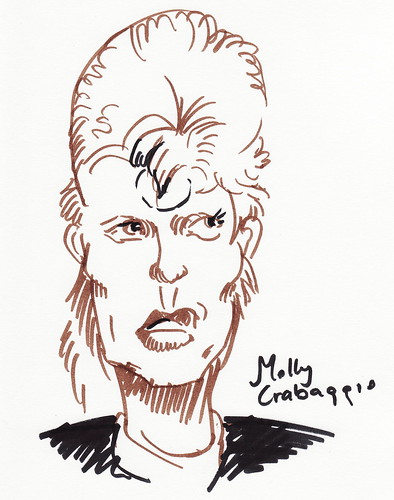
Molly Crabapple: Eyes to the skies and halfway between classy and goofy, as is the wont of Molly’s dandies.
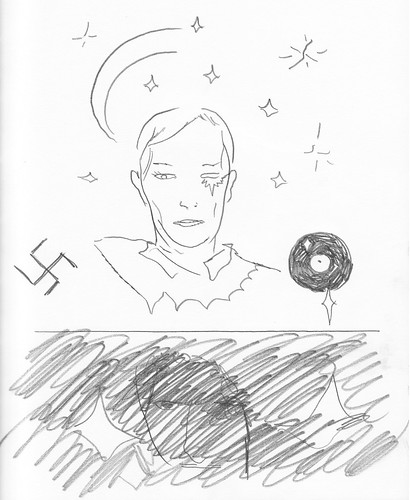
CF: CF seemed excited to draw Bowie, until he flipped through my sketchbook, which he said was intimidating. He handed this back, saying “He was a great Nazi sympathizer.” That’s something of a misrepresentation, as a matter of fact–and something of a disconcerting addition to the sketchbook–but one does not look gift sketches in the mouth, I suppose.
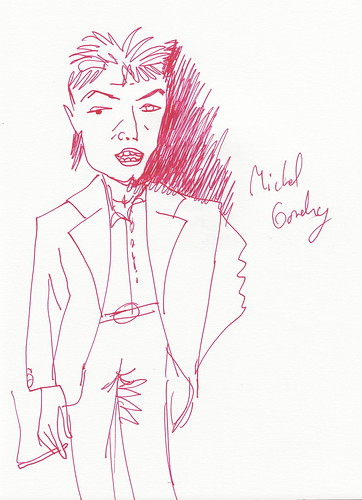
Michel Gondry: Yes, that Michel Gondry. The fact that I have a sketch of David Bowie by the man who directed the video for “Everlong” is pretty goddamn wonderful if you ask me. Gondry insisted I buy his comic book in exchange for the sketch, which seems fair.
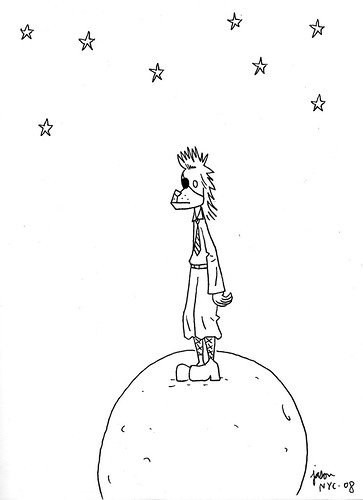
Jason: The most underappreciated cartoonist around, given his talent, Jason commanded huge sketch/autograph lines at the show. He actually apologized for “getting the clothes wrong” on this, but Bowie as an anthropomorphized doggie version of The Little Prince? No apology necessary.
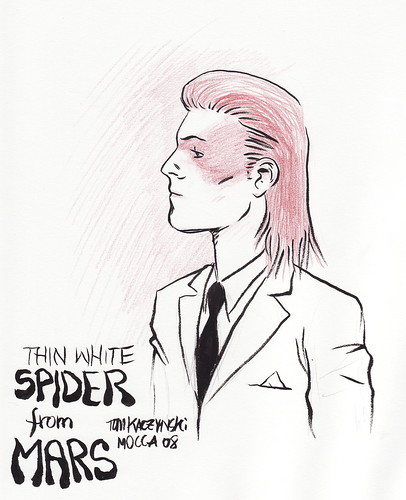
Tom Kaczynski: A mash-up of Bowie’s two most stylish eras. My favorite sketch of the show. Look at that luscious red!

Bill Plympton: Yes, that Bill Plympton. When I saw this animation legend’s name on the guest list for the show, I got pretty excited. It paid off.
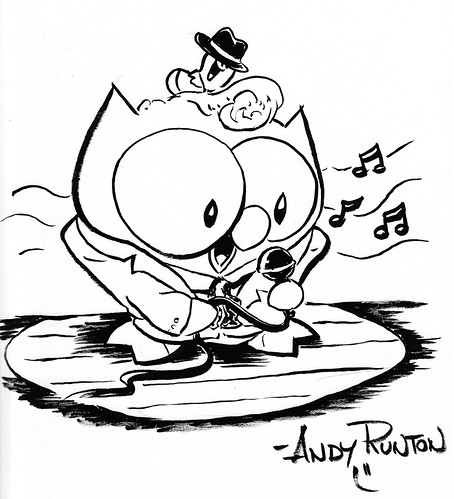
Andy Runton: Runton draws his trademark character Owly as any other character you like. He went for one of Bowie’s well-dressed crooner phases for me. Compare and contrast with the CF, if you will.

Dash Shaw: I get kind of a silent-movie expressionist vibe from this one, don’t you?
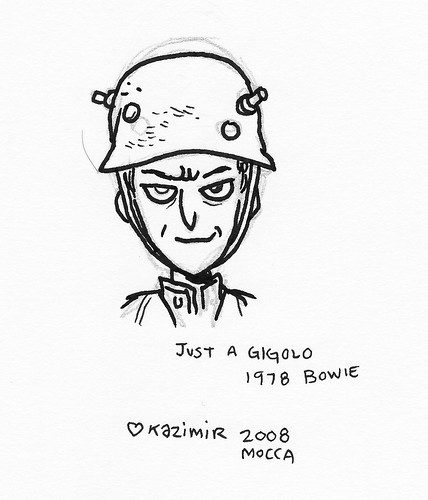
Kazimir Strzepek: This shot of Bowie, based on his soldier-boy look from the film Just a Gigolo, looks like it could have come right from one of Kaz’s post-apocalyptic fantasies.
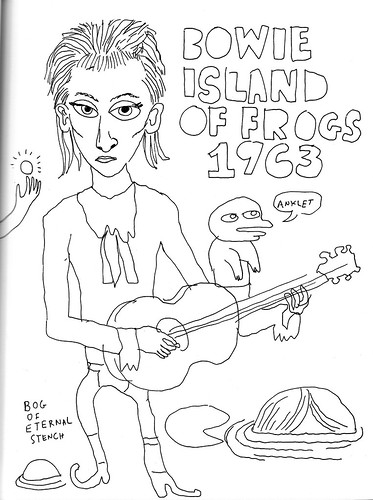
Matthew Thurber: Thurber made a pretty wild Bowie minicomic called What Kind of Magic Spell to Use, an alternate-reality take on the recording of the Labyrinth soundtrack with producer Steve Albini (!). Needless to say he was a must-get on my list.
Don’t forget to check out the sketches I got at MoCCA 2007 and SPX 2007, or see the whole shebang as a Flickr set. Drink to the men (and women) who draw sketches for you and I! Drink, drink, drain your glass, raise your glass high!
Carnival of souls
June 13, 2008* Shock Till You Drop reports that Ryuhei Kitamura’s adaptation of Clive Barker’s Midnight Meat Train will receive a limited 100-theater release. So much for The Strangers saving R-rated horror, eh wot?
* SPOILERY Descent/Descent 2 tidbits ahoy: The entire cast of the original Descent will be returning in The Descent 2 via flashback. (Via Bloody Disgusting.) So yes, the new film will pick up where the American cut of the first film left off. Since I find being haunted by guilt and failure for the rest of your life to be a more disturbing source of fear than remaining stuck in a cave full of creatures trying to eat you, I’ve always prefered the U.S. version to the U.K. version, so this news makes me pretty happy.
* At least one of those rumored Battlestar Galactica TV movies looks like a going concern for this year, while the show’s Sopranos-style “final season part deux” may pick up an additional 2 hours to go from 10 to 12, according to the Chicago Tribune’s Maureen Ryan. I’d have been marginally more excited about this news before the current half-season, but hey, I hear tonight’s episode is a real mind-blower. We’ll see. (Via Jason Adams.)
* I enjoyed Keith Uhlich’s essay on the new four-film Rambo DVD box set a great deal, because I think in comparing John Rambo varyingly to Frankenstein’s monster, Tintin, and the Hercules of Greek myth he gets at the heart of the character: Rambo is war. He’s offensive, heroic, and disturbing, easy to harness to propagandaiacal aims yet always too strange, complex, and dangerous to stay harnessed. (Via The House Next Door.)
* The Groovy Age of Horror’s Curt Purcell continues his examination of supernatural horror with a second critique of Freud’s “The Uncanny,” this one focusing on Freud’s (mis?)interpretation of his key source, E.T.A. Hoffman’s “The Sand-Man.”
* Your quote of the day comes from Jim Henley, discussing recent witch hunts in Kenya:
A working definition of “witch” has long been “a widow with some property.”
* Finally, just a friendly reminder that you can buy my comic book Murder for the low low price of three American dollars at the Partyka shop.
Comics Time: Paradise Kiss Vols. 1-5
June 13, 2008Paradise Kiss Vols. 1-5
Ai Yazawa, writer/artist
Tokyopop, 2002-2004
Approx. 180 pages each
$9.99 each
Originally written on September 28th, 2004 for publication in The Comics Journal
I never really understood the notion of style (as opposed to fashion) until the lead singer of the Dandy Warhols explained it to me. Courtney Taylor-Taylor, the ectomorphic frontman for the Portland-based purveyors of retro-decadent glam pop, told me during an interview that style is merely the outward manifestation of a person’s insides. “How should my clothes fit and how should my hair look [is determined by] which look for me will better represent, at first glance, what I am about,” he said. (A fringe benefit, he later added, was that this acted as a filter against meeting people who don’t already like you, so you end up involved in fewer dead-end conversations.)
Coming as it did at a point in my life where I was in the throes of an obsession with David Bowie, Roxy Music, Velvet Goldmine, and the entire glitter aesthetic (one which continues to this day), Taylor-Taylor’s words were a revelation to me. Though a combination of poverty and laziness has kept me from perfecting the type of personality-in-wardrobe-form the rock star was advocating, I continue to applaud those with the creativity and willpower to make a go of it.
It’s undoubtedly this reverence for style, combined with a comics fan’s appreciation for a unique story well told, a singular artistic sensibility, and stories about and for teenagers that condescend to neither character nor reader, that leads me to dig Paradise Kiss. Published by manga giant Tokyopop and prepared for the English-language audience by a bevy of translators and adaptors, Parakiss (to crib a familiar abbreviation the characters themselves use when referring to both the clothing design studio around which the comic centers and, in regular breakings of the fourth wall, the comic itself) is a pip of a series, five volumes of angst, lust, and fabulous, fabulous clothes.
Yazawa’s art serves as a wonderful descriptor of all three. Fans of the McCloudian notion that art and story are indistinguishable in comics will find much to love here, since (to these relatively inexperienced eyes) the graphic conventions of shoujo manga (the razor-thin line against acres of white backgrounds, the effete, wire-thin figures, even the riot of pseudo-dialogue and untranslated sound effects peppered throughout translated works) are for once harnessed to a story that makes sense out of them. When studious and beautiful prep-schooler Yukari gets drawn into the world of four students at a high school for the arts, Yazawa’s intricate and ornate draftsmanship does effective double duty, skillfully capturing not only the sensuous and emotional confusion our heroine feels as her world changes, but the gorgeous, Velvet Goldmine-quoting boy (George) who seduces her, and the exquisite, anachronistic clothes he designs.
Those clothes are a highlight, undoubtedly; I found myself looking forward to each chapter’s title page, since those pages boast pin-up images of Yukari (“Caroline,” to her Anglophilic new friends) and the rest of the crew in painstakingly drawn couture. Such moments also pop up in the narrative as well, as during the climactic fashion show, which is lovely enough from both a graphic and storytelling point of view that it ably bears the four volumes’ worth of weight placed upon it. In all cases it’s evidence that the apparent frivolity of Yazawa’s art is icing on a cake that’s not just substantive, but no less delicious for it.
The same can be said of her writing. We’re largely in teen soap territory here, but that’s undercut with a surprising deftness in characterization, brutal at times (George’s attention-starved ex-model mother, George himself in his egocentricity and sexual predation) and unexpectedly warm at others (gruff punk Arashi’s unechoed concern at the way Yukari is ditching her previous life more or less on a whim, young George’s gift to his budding drag-queen friend Isabella). There’s also a sexual frankness that’s quite refreshing: Sex is treated neither as an idealized pathway to spiritual perfection nor as a sweaty and sordid means of disease transmission, but as something that can be a great deal of fun and, therefore, a great deal of trouble. When Yukari walks in on her new friends Miwako and Arashi fucking on a pool table because neither of them has any privacy in their bedrooms, early in the first volume, I’m sure I’m not the only reader who thought “yep, that’s about right.” (The fact that the scenes are so opulently drawn reminds us, to paraphrase Trainspotting, that if it weren’t so pleasurable we wouldn’t do it.)
If anything, it’s this fidelity to the actual experience of teenage sexuality and gender issues that can be off-putting. At no point does Yukari (or Miwako), seem to think of her own pleasure as paramount when it comes to sex; the act is typically initiated either through pressure (in one alluded-to incident, physical) or as a surefire way to change a painful subject, and is always seen through the lens of the boy involved–how it makes him feel, about the relationship, about her; how she feels about the relationship, about him. Of course, I’ve seen little evidence that this unfortunate state of sexual affairs for Yukari is not indicative of how nearly all teenage girls are conditioned to view sex, so perhaps Yazawa is to be applauded for telling it like it is rather than chided for not setting a better example. Ditto her portrayal of Yukari’s entrée into the world of professional modeling–the poor girl is chided on several occasions to stop eating so much, a scene that will make the eating disordered in the book’s audience either cringe in horror or chuckle in recognition. (Speaking of that audience, how cool is it to read a comic book that assumes its reader is a girl? And one in which beautiful male characters are paraded around as eye candy and objects of the gaze?) Moreover, high school may suck, and we all wanted to escape from it, but if you’re a girl looking for freedom from conformity, stricture and misogyny, the fashion industry is not exactly a place I’d advise you to run to. Then again, all the characters seem to gain some awareness of this art-cum-industry’s faults, particularly in the book’s unusually nuanced epilogue, so it’s not like Parakiss is peddling the same line of bullshit as Cosmopolitan.
In other words, Paradise Kiss is about style, not fashion, despite its industry trappings (and despite appearing in serialized format in a Japanese fashion magazine). For George, Yukari, and the rest of the Paradise Kiss studio, the clothes are never about riding the crest of a trend or obeying external expectations–despite the fact that their success as designers (and as people) would be far more likely if that were the case. The clothes are about representing, at first glance, what they as young men and women (and drag queens) are all about. A bunch of precocious, horny, fucked-up 17-year-olds may not know what they’re all about, of course, but maybe that’s what makes their sense of style, and this manga, so enthralling.
Notes on two series
June 12, 2008I finished Death Note the other day, and wow. I had no idea a comic book could be that thrilling and suspenseful! Nothing was off limits, no one was safe, and because of that the suspense sequences were viscerally, physically exciting, as much so as any movie. The car chase, the hideout siege, the moment-to-moment final showdowns between Kira and his antagonists–I was tearing through the pages and cheering and gasping like I don’t think I’ve ever done with a comic before. Well done, Ohba and Obata.
I’m five episodes into the final season of Deadwood, and…I almost don’t know what to say. So I probably am not going to say much of anything until I can sit and think of an entry point to talking about the series. It’s moving and magnificent on an episode to episode basis, that’s for sure. Today I watched a scene and at the end of it I had an enormous headache, and I suddenly realized I’d literally been holding my breath. Blown away.
It’s making me a lot less impressed with The goddamn Wire, too.
Carnival of souls
June 11, 2008* Apparently, Marvel may have decided they don’t need Jon Favreau for Iron Man 2. Favreau himself says they haven’t even gotten in touch with him about it yet. That’s pretty stupid of Marvel. Perhaps the outcry all over the Internerd will shame them into bringing him back.
* FourFour’s Rich Juzwiak pays photographic tribute to Anton Corbijn’s biopic of Joy Division lead singer Ian Curtis, Control. Unforgivable that I still haven’t seen this, I know.
* I’ve been waiting for the right time to link to Karl Kerschl’s lovely webcomic about a mute Sasquatch/Yeti and his misadventures in a forest, The Abominable Charles Christopher, and today’s installment seems like the right time:
Comics Time: Fox Bunny Funny
June 11, 2008Fox Bunny Funny
Andy Hartzell, writer/artist
Top Shelf, June 2007
106 pages
$10
This very good funny-animal comic stands out from the anthropomorphized pack because its visual metaphor strengthens the impact of its more outrageous moments rather than diluting it. Anyone can get some mawkish sentimentality out of casting a cuddly critter in their tale of modern urban ennui, or flip the script and go for some guffaws by doing the umpteenth Fritz the Cat mammals-with-mammaries sex farce. Hartzell aims elsewhere in Fox Bunny Funny.
The first highlight is the violence. We meet our fox protagonist as an awkward adolescent in a broadly drawn conformist suburbia of sitcom vintage, where his fellow foxes kill and consume bunnies with gusto. When our hero is discovered hopping around behind closed doors wearing a bunny costume (I’ve gotten caught doing worse), he’s shipped off to a fox-scout camp where he’s trained to use an impressively horrible beartrap-shooting weapon on bunny-shaped bullseyes. When he proves an excellent marksman, his scoutmaster drags him along on a bona-fide hunt…to the town where the bunnies live with all the same civilizational niceities as the foxes. Hartzell depicts their rampage with disturbing imaginativeness–the foxes run bunnies in cars off bridges, plow through restaurants in their SUV, then smash their way into a bunny family’s home, burst in on their Anne Frank attic hideout, and slaughter them. Eventually the hero flees to a bunny church (the suffering of the bunnies analogized to the suffering of Christ), but when he’s discovered frolicking with the congregation by his fellow scouts, he can’t take the pressure and leads the slaughter himself. Obviously, making both predators and prey into human-style civilizations heightens the savagery of the foxes’ attacks on the bunnies. It may be a metaphor for war or racism or meat-eating or all three at once; mostly it comes across as a refreshingly harsh indictment of human brutality and stupidity in all its forms.
The second strong point is the depiction of a shared fox-bunny counterculture. After the murder in the church, we join our hero years later, where he’s a perfectly normal member of the bunny-eating masses. When a bunny prankster attacks his house, he’s led on a chase through the proverbial and literal rabbit hole into a West-Village-meets-Haight/Ashbury urban freak mecca, where bunnies and rabbits of all genders mix and mingle enthusiastically. Hartzell saves some of his most exciting cartooning for this sequence, including a Where’s Waldo/Hard Boiled-style two-page spread of the scene. What’s special here is that comics, particularly alternative comics, takes the existence of a counterculture for granted. Hartzell sets up the structure of Fox Bunny Funny in such a way that the discovery of this counterculture feels like a legitimate revelation. Do you remember when you were younger, and you first started pursuing countercultural interests and hanging out with the freaks or ‘bangers or emo kids or skaters or whatever they were where you grew up, or first journeyed to a big city and saw that people could be weird or gay and not be looked at like zoo animals for it, and this simple fact felt like both an explosion of self-liberation and a massive “fuck you” rebuke to society at large? Hartzell nails that. And then he goes one step weirder and more asseritve with the conclusion. All with impeccable, wordless kids’-book cartooning. I think I love this comic.
Carnival of souls
June 10, 2008* Here at ADDTF I enjoy taking credit for being right, since it happens so infrequently. Regular readers may note that I’ve been defending The Incredible Hulk against sight-unseen unfavorable comparisons to Iron Man and kvetching about the supposedly prima-donnaish behavior of star Edward Norton for months now. So I feel some vindication in reading my friend Zach Oat’s rave review of the movie at Television Without Pity and good ol’ Harry Knowles’s report that Norton is, in fact, doing press for the film (in roughly the same capacity he’s done so for most of his other movies). Speaking of, here’s a roundtable interview between Norton, director Louis Leterrier, and soul-crushingly pretty co-star Liv Tyler at Moviefone. I bet you I like this movie.
* Fun fact I learned from Zach’s review: Lou Ferrigno voices the Hulk in the movie! Fun fact I learned from the roundtable interview: The RZA was on set! Fun fact I learned from the roundtable interview number two: Liv Tyler knows Gizmo’s little song from Gremlins by heart! (Even if she calls the movie Goonies.)
* Grant Morrison’s implied suggestion that fans with beef over the continuity blips in his Final Crisis #1 should be so kind as to sit on it and rotate went over like gangbusters with me, but some other folks are more skeptical. Tom Spurgeon says it’s unfair to fault fans conditioned for functional continuity to expect it, while in a lively comment thread on thishyere blog Jim Treacher argues that by working on a story completely dependent on continuity and then rejecting pleas for said continuity, Morrison’s trying to have it both ways. Sean of the late, lamented Strange Ink and Bruce Baugh weigh in with counterarguments in that same thread.
* In other Morrison news, Big Sunny D (!!!) muses on the Mad Scot’s oddly absorbing Batman run.
* At Wizard’s Indie Jones blog, my compadre David Paggi posts his MoCCA report (with photos), and ends it with a phrase I never thought I’d hear uttered by anyone who didn’t grow up on my block during the ’80s.
* The New York Times reports that nine inch nails’ Trent Reznor is indeed planning a TV series based on his dystopian concept album year zero with producer Lawrence Bender. (Via Pitchfork.)
* In the “interesting-looking reviews of films I haven’t seen yet,” CRwM of And Now the Screaming Starts takes a look at blogosphere favorite Inside.
* Curt Purcell of The Groovy Age of Horror continues his exploration of supernatural horror with an in-depth examination of the linguistic underpinnings of Freud’s conception of the Uncanny.
* A multitude of my League of Tana Tea Drinkers horrorblogging compatriots tackle Evil Children in horror.
Murder for hire
June 10, 2008My comic book Murder is now available for purchase at the Partyka shop for the bargain price of $3.

Carnival of souls
June 9, 2008* I recommend Joe “Jog” McCulloch’s MoCCA report.
* I do not recommend reading Platinum Dunes producer Brad Fuller’s rationale for remaking Rosemary’s Baby:
“I want to address that,” Fuller said. “Because if we don’t do Rosemary’s Baby, somebody else [will]. They’re not going to pass on it. And, like I said, being horror fans like we are, we would want to take the opportunity and take a shot at it, rather than read about someone else doing it. So all the s–t we get for doing these things–it really just comes out of being huge fans and wanting to take a shot, you know?”
Fuller added that they have not come up with a story for the reboot of Rosemary.
This line of reasoning in almost beautiful in its utter lack of cluefulness on every level. But don’t worry, everyone, “it really just comes out of being huge fans.” See, he’s one of us, my fellow idiots horror buffs! (Via the equally appalled Jason Adams.)
* Here’s a very, very, very long examination of the final scene in The Sopranos that makes a fairly convincing case for interpreting it in one particular direction rather than another. It goes in for close-reading that borders on clue-spotting, but that is by no means the sole source of its argument–the most convincing aspects are the ones drawn from a series of increasingly less cryptic statements I’d never heard before from creator David Chase. (Via Keith Uhlich.)
* This interview with Grant Morrison about Final Crisis #1 is, as they say, FULL OF WIN. In large part the questioner, Newsarama’s Matt Brady, focuses on continuity discrepancies between FC #1 and various miniseries from the past year or so, particularly the widely rejected weekly “spine of the DC Universe” series Countdown. Morrison’s answers, which explain that most of the events we’ve seen so far that contradict what happened in his comic were written after his was completed, are beyond delightful:
Obviously, I would have preferred it if the New Gods hadn’’t been spotlighted at all, let alone quite so intensively before I got a chance to bring them back but I don’t run DC and don’t make the decisions as to how and where the characters are deployed.
[snip]
…bear in mind that Countdown only finished last month so Final Crisis was already well underway long before Countdown and although I’ve tried to avoid contradicting much of the twists and turns of that book as I can with the current Final Crisis scripts, the truth is, we were too far down the road of our own book to reflect everything that went on in Countdown, hence the disconnects that online commentators, sadly, seem to find more fascinating than the stories themselves.
[snip]
The way I see it readers can choose to spend the rest of the year fixating on the plot quirks of a series which has ended, or they can breathe a sight of relief, settle back and enjoy the shiny new DC universe status quo we’re setting up in the pages of Final Crisis and its satellite books. I’m sure both of these paths to enlightenment will find adherents of different temperaments.
I don’t know why this particular interview is reducing me to Internerd speak, but that’s just pwnage all over the place. It also scratches a real itch for me because I’ve spent most of the time since the issue came out debating with some friends of mine whether or not Grant “should” have tweaked a line or two to “fix” the “problems” of his comic not lining up with Jimmy Palmiotti & Justin Gray’s or whoever it was that did the New Gods stuff in Countdown. Even aside from the temporal/logistical issues Morrison himself points out, the answer is “of course not.” He’s a writer, not a janitor, and his obligation is to tell a good story, not to provide a seamless experience for devotees of a shared fictional universe cobbled together from the work of thousands of disparate creators by corporate diktat.
Anyway, the interview also explains how the issue connects with similar elements in Seven Soldiers, sticks the book into Identity Crisis a bit, and confirms my theory as to why the book took an offhand approach to Martian Manhunter’s death:
we wanted to open with a nasty, execution-style death of a superhero as a way of demonstrating how far behind us the Silver Age is. We’re conditioned to expect the hero to fall after a noble struggle or to give his life saving the universe but this had to be different. The scene was very much about calling time on expectations and letting our readers know up front that the rules have changed. Evil is getting away with it. Things are going to get nastier and grubbier and scarier before it’s over, just like in the real world.
I look forward to subsequent issues.



